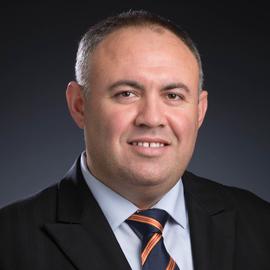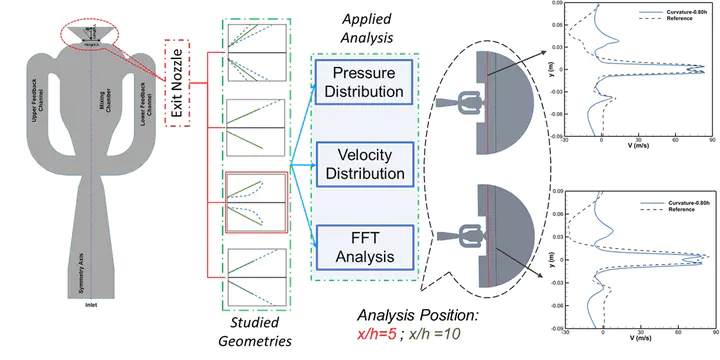The Influence of Exit Nozzle Geometry on Sweeping Jet Actuator Performance
Mobashera Alam, Kursat Kara
February, 2022
Abstract
When pressurized with a fluid, the sweeping jet actuator (SWJA) emits a self-induced and self-sustained temporally continuous, but spatially oscillating bi-stable jet at the outlet. The SWJA adds up local momentum using the Coanda extension without any moving parts and, therefore, can be a promising tool for suppressing aerodynamic flow separation. However, the SWJA needs to be integrated into curved aerodynamic surfaces with an angle. The present study focuses on investigating the effects of various exit nozzle geometries on the flow field. The geometric parameters considered were the exit nozzle angle, diffuser arm length, and curvature. The working fluid was air, and the mass flow rate was 0.015 lb/s. A set of time-dependent flow fields was computed using a two-dimensional unsteady Reynolds-averaged Navier–Stokes (URANS) simulation. The time history of pressure was recorded inside the upper and lower feedback channels. The jet oscillation frequency was obtained by employing the fast Fourier transform (FFT) for all datasets. The results were compared against the baseline case and data available in the literature. The results showed that external geometric variations at the nozzle exit had a negligible impact on the oscillation frequency. However, there were notable effects on the pressure and velocity distribution in the flow field, indicating that the actuator had sensitivity towards the geometric variation of the exit nozzle—the wider the exit nozzle, the lower the downstream velocity. Notably, we observed that the mean velocity at the exit nozzle downstream for the curvature case was 40.3% higher than the reference SWJA.

Mobashera Alam
M.Sc., Current Position: Design Engineer at American ShiZuki Corporation

Kursat Kara
Associate Professor, Mechanical and Aerospace Engineering
Kursat Kara is an Associate Professor of Mechanical and Aerospace Engineering at Oklahoma State University and principal investigator of the Kara Aerodynamics Research Laboratory. His research spans hypersonic boundary-layer physics, unsteady aerodynamics, and the emerging interface of quantum computing and fluid dynamics. A dedicated educator and mentor, he teaches core and advanced courses—including Fundamentals of Aerodynamics, Computational Fluid Dynamics, Boundary-Layer Theory and Transition, and Quantum Computing—and supervises graduate and undergraduate projects in high-fidelity simulation and data-driven modeling. His work has been funded by NASA, NSF, Oklahoma NASA-EPSCoR, NAVAIR, ANSYS, and IBM Quantum. In 2025, he received the CEAT Excellent Faculty Award and was nominated for both the 2024 Excellent Teacher Award and the 2025 Excellent Faculty Award by OSU’s School of Mechanical and Aerospace Engineering. Dr. Kara earned his Ph.D. from Old Dominion University with a dissertation on hypersonic boundary layer receptivity to acoustic disturbances. He began his career as a research engineer at New England Analytics (supporting Sikorsky Aircraft), then completed a post-doctoral appointment at Penn State in hot jet simulations for aeroacoustics. In 2010, he helped establish the Aerospace Engineering Department at Khalifa University—where he won the President’s Faculty Excellence Award for Outstanding Teaching in 2015—before joining OSU. An active member of AIAA and APS, he served on the AIAA Applied Aerodynamics Technical Committee (2012–2021) and chaired/co-chaired multiple AIAA conferences. He also sits on the editorial board of Nature Scientific Reports and guest-edits its Quantum Computing collection.
